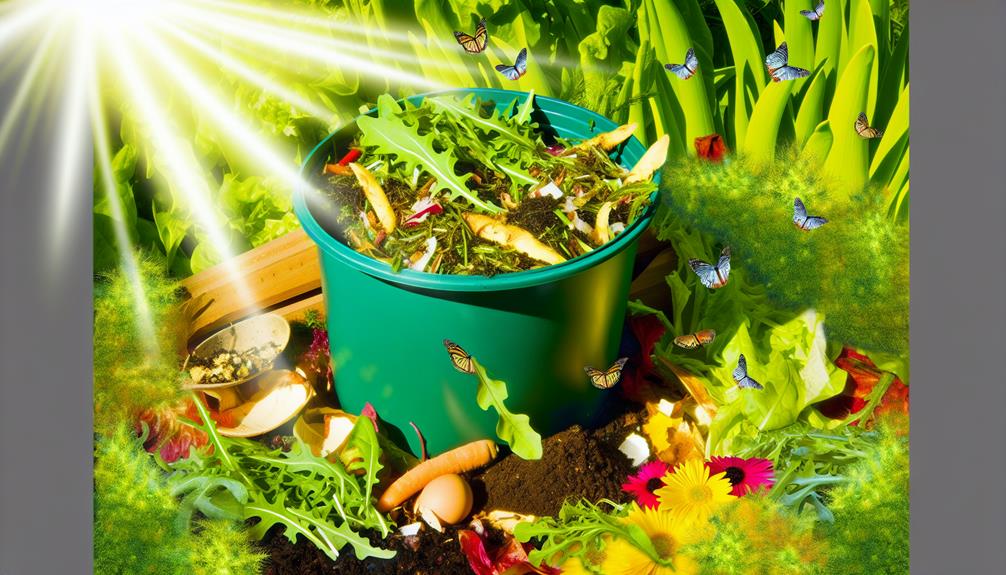

Yes, you can compost arugula. Make sure to chop it into smaller pieces for efficient decomposition. Remove any rubber bands or ties and make sure it’s clean and free of chemicals. Due to its high water content, mix arugula with brown materials like leaves or paper to balance your compost pile’s carbon-to-nitrogen ratio.
Turn the pile regularly to promote even heat distribution and monitor moisture levels to prevent strong odors. Composting arugula can recycle organic waste, lower methane emissions, and enrich your soil, reducing the need for synthetic fertilizers. There are even more insights to explore for maximizing your compost’s effectiveness.
Composting arugula offers numerous environmental and gardening benefits. When you compost arugula, you’re recycling organic waste, which reduces landfill usage and lowers methane emissions.
Arugula, rich in nitrogen, helps create a balanced compost mix when combined with carbon-rich materials like dried leaves. This essential balance is necessary for an efficient composting process.
By adding arugula to your compost pile, you’re also enriching the compost with essential nutrients, which, when used in your garden, improves soil structure and fertility. Healthier soil means stronger plants and better crop yields.
Plus, composting reduces the need for synthetic fertilizers, promoting a more sustainable gardening practice. So, next time you’ve got arugula scraps, toss them into your compost bin for a greener garden.
Also Read: Can You Compost Bacon Grease?
You might encounter a few challenges when adding arugula to your compost pile. One issue is its high water content, which can make the compost too wet, slowing decomposition. To guarantee this, balance it with dry materials like leaves or straw.
Another challenge is its strong odor, which can attract pests. Make sure to bury it well within the pile.
Additionally, arugula’s rapid decomposition can create heat, potentially leading to a hot spot in your compost. Turn the pile frequently to confirm even heat distribution.
Before adding arugula to your compost pile, chop it into smaller pieces to speed up decomposition. This allows microorganisms to break down the material more efficiently. Remove any rubber bands or ties that might be attached to the arugula, as these aren’t compostable.

If the arugula is wilted or past its prime, it’s still fine to compost. Make sure the leaves are relatively clean and free of pesticides or chemicals, as these can disrupt the composting process.
Mixing the chopped arugula with other green materials, like fruit scraps, and balancing it with brown materials, such as dry leaves or cardboard, helps maintain an ideal carbon-to-nitrogen ratio. This balance is essential for creating nutrient-rich compost.
Also Read: Can You Compost Balloon?
There are several effective methods to compost arugula, each with its own benefits and considerations. You can use traditional composting, which involves layering green (nitrogen-rich) and brown (carbon-rich) materials. Arugula, being a green material, should be balanced with browns like dry leaves.
Another method is vermicomposting, where worms break down organic matter. Arugula works well here but use it sparingly to avoid overwhelming the worms.
Lastly, bokashi composting uses a fermentation process. Arugula can be added to the bokashi bin, but you’ll need to bury the fermented mix in soil afterward.
Each method has its pros and cons, so choose one that fits your space, time, and effort level.
To guarantee successful composting of arugula, start by chopping it into smaller pieces to speed up the decomposition process. Mix the arugula with a variety of other compostable materials, such as kitchen scraps and yard waste, to create a balanced compost pile.

Make sure you maintain a proper balance of green (nitrogen-rich) and brown (carbon-rich) materials. Turn the compost regularly to aerate it and promote even decomposition. Keep the compost pile moist, but not too wet; it should feel like a damp sponge.
Monitor the temperature to make sure it’s decomposing effectively—ideal range is 135-160°F (57-71°C). If the pile starts to smell, add more brown materials to offset any excess moisture or nitrogen.
Composting arugula is a straightforward and beneficial process. Simply chop it into smaller pieces, and mix it well with other compost materials.
Use methods like traditional compost bins or vermicomposting for best results. Remember to maintain a balanced mix of greens and browns, and regularly turn the pile to speed up decomposition.
By following these steps, you’ll enrich your compost and contribute to a healthier garden. Happy composting!
